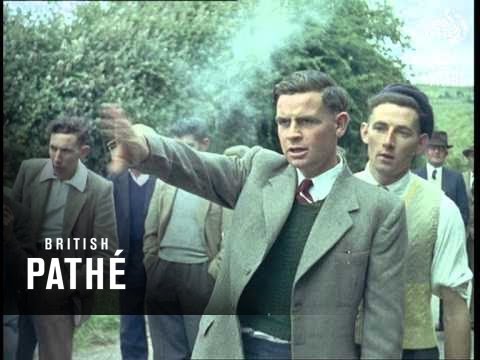Road bowling is an Irish sport in which competitors attempt to take the fewest throws to propel a metal ball along a predetermined course of country roads. The sport originated in Ireland and is mainly played in Counties Armagh and Cork. Spectators often bet on the outcome and proffer advice to their favoured competitor in the course of a match or “score”. Road bowling in Ireland is governed by the voluntary Irish Road Bowling Association.
The “bowl” or “bullet” is an iron and steel cannonball of c.6.5 centimetres (3 in) diameter and 28 ounces (794 g) weight.There are two or more players or teams in a match or “score”.The one with the fewest shots to the finish line wins. If two players or teams approach the finish line with equal shots, the winner is decided by which throw goes farther past the finish line.
A road shower advises the thrower about the throw (or shot) much like a golf caddy, while another helper stands ahead of the thrower, feet apart, to show the best line or path in the road.
The thrower runs to the throwing mark and, in the Northern or County Armagh style, extends the arm and bowl behind him as he runs. At the throwing mark the arm is snapped forward by arching the back and shoulders, releasing the bowl underhand before stepping over the mark.
In the Southern or County Cork style, as the thrower runs to the mark the arm and bowl are lifted up and back, then whirled downward into an underhand throw, releasing the bowl before stepping over the mark.
Wherever the bowl stops (not where it leaves the road surface), a chalk mark is made at the nearest point on the road and the next throw is taken from behind that mark.
Over tight curves, or corners where two roads meet, the bowl may be thrown through the air (lofted). The loft must strike the road or pass over it. If the loft fails to reach the road, it counts as one shot, and the next throw must be taken again from the same mark.
Fintan Lane traces the sport to the 17th century and suggests that it was once far more widespread than it is today. Until the 19th century, the game was also played in Scotland, the north of England and in North America. In the past, players were given twenty shots (a score) each, the winner determined by who went the greatest distance. Though the modern game is a fixed distance in fewest shots, the expression “score” for a match survives. Disputes between competitors or spectators often created public disturbance and court cases resulted down to the 1950s.
Bol-Chumann na hEireann was formed in 1954 to replace the less organised All-Ireland Bowl Players Association. There were irregular contests between Cork and Armagh champions over the decades, but the first national championship between them was in 1963.The first World Championship was as part of Cork 800 in 1985.
